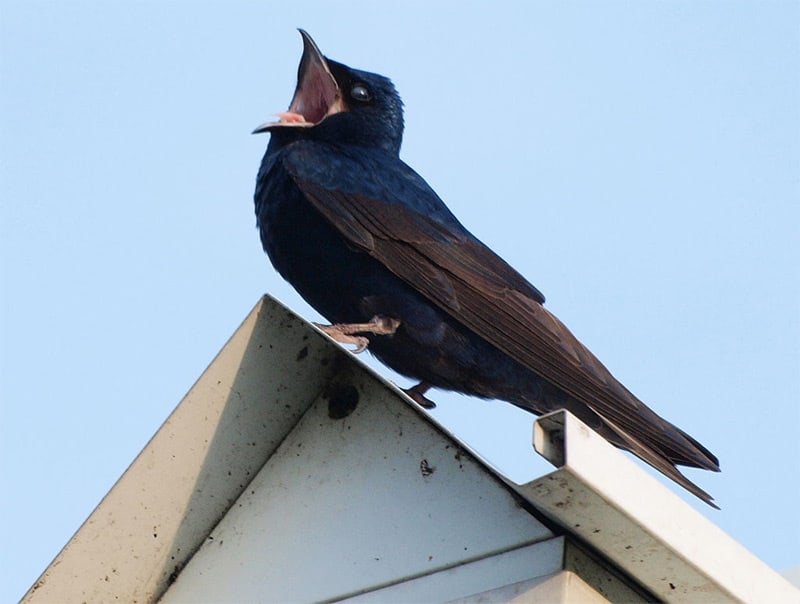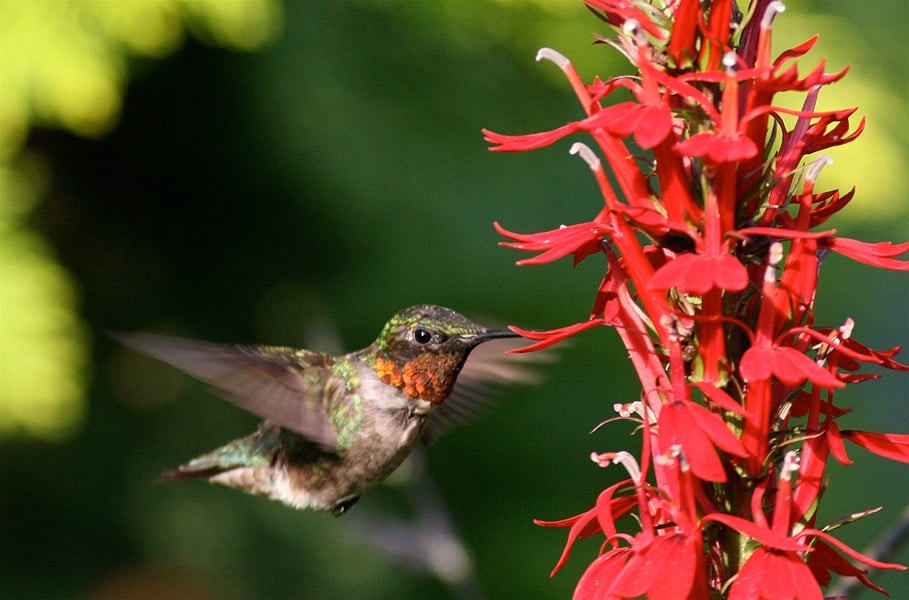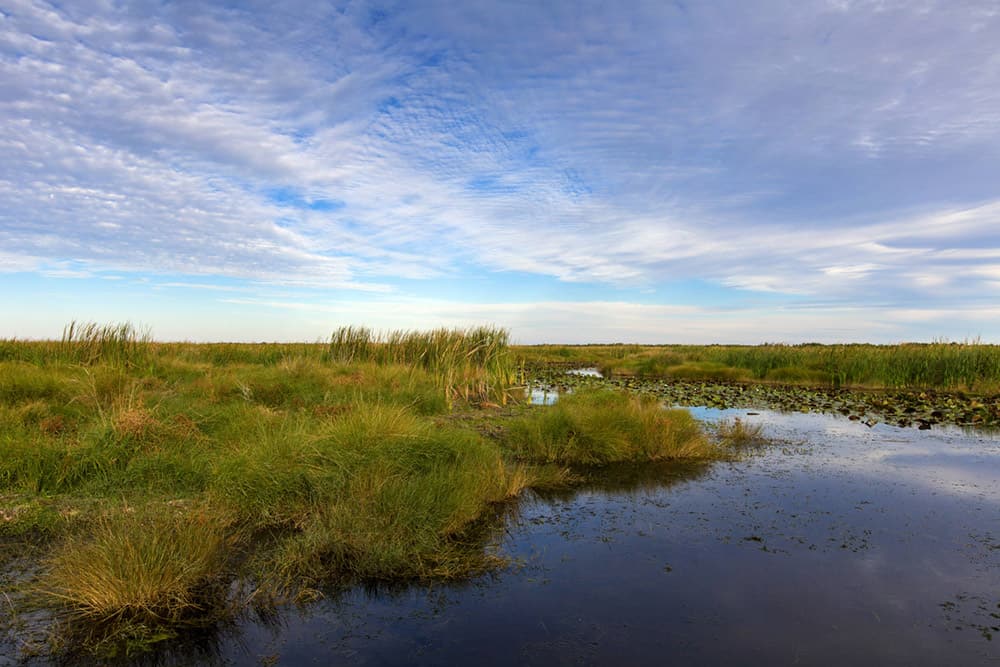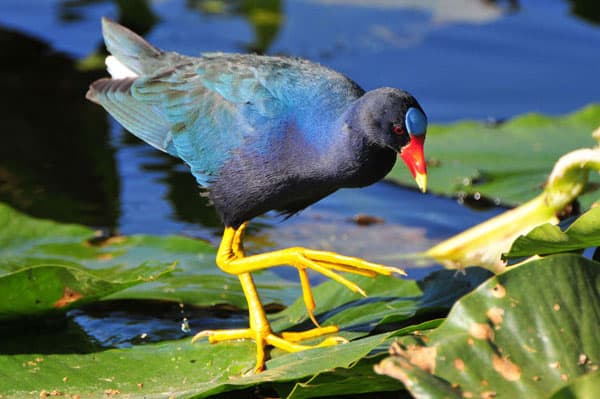Spring Birds of Alabama (March, April, May)
Spring starts early in Alabama and is breathtaking. The azaleas and dogwoods are blooming, and new birds are arriving daily. Spring migration offers some of the best birding opportunities as neotropical migrants flood across the gulf, many making landfall at such hotspots as Dauphin Island and historic Fort Morgan. Swallows—purple martins, barn and northern rough-winged—lead off by mid-February, and Louisiana waterthrushes, northern parulas, ruby-throated hummingbirds, and a host of shorebirds begin arriving by early March. By the beginning of April the floodgates are wide open and migration along the coast continues through the month and into mid May in the northern part of the state.
Dauphin Island attracts hundreds of birders in April when the whole island can become a veritable aviary. One of the favorite places to view birds as they land after flying across the gulf is the Shell Mounds, which are really several acres of discarded oyster shells left over from a prehistoric American Indian commercial oyster enterprise. Other places include old Fort Gaines, a saltwater marsh at the small airport, the Audubon Sanctuary, and several miles of beach. On the opposite side of Mobile Bay lies Fort Morgan, where authorized banders set up each spring (and fall) and who always have time to share their birds with the public.
The most spectacular event of spring migration is a “fallout,” caused by a weather front in the Gulf of Mexico. If the birds encounter wind and rain during their flight, they may become so exhausted that, tragically, many simply have no energy remaining to go farther, and they settle to the water and die. If they encounter these conditions late enough in their trip, they may be able to make landfall, but only to drop from the sky at the first opportunity to rest and refuel. On such occasions, which most birders only rarely witness, the trees along the coast and even the beaches may be covered with exhausted birds. Once a birder gets past the underlying tragedy of the situation, it becomes a awe-inspiring chance to see hundreds of tanagers, warblers, thrushes, orioles, vireos and other birds. Extreme care must be taken not to stress these birds any more than they already are. While it is quite easy to approach very closely, responsible birders will remain a respectful distance or keep perfectly still and wait for the birds, unaware of human presence, to come to them.
My wife and I once witnessed a fallout where the sound of the birds was so loud as to make hearing each other difficult. The trees were occupied by hundreds of scarlet tanagers. The birders stayed until dark, drinking in the incredible sight. They returned early the next morning expecting to see more of the spectacle, only to be greeted by an eerie silence. During the night, every bird had continued its migration northward. One yellow-billed cuckoo lay dead on the ground, its breast muscles, employed for flight, completely gone. The bird had literally used up its muscle tissue, burning it as fuel, only to die on shore because it was no longer able to fly.
Although the coast is most fruitful, particularly if there are adverse wind conditions, the rest of the state can be quite exciting. If the conditions are favorable, that is to say, if there is a good tailwind during the trans-gulf flight, many birds may fly more than 200 miles inland before stopping. Whether they stop first on the coast or fly inland before their first stop, most of the birds that cross the gulf migrate northward through the state. This can make early mornings from early April to mid-May a feast for the eyes throughout the state; however the chances improve from Birmingham northward. Additionally, circum-gulf migrants, those that migrate around the gulf through Mexico and Texas, are only very rarely seen along the coast, but north Alabama, beginning about Birmingham, can yield these special migrants in late April and May. For instance, each year a few Canada warblers are sighted in the Birmingham Botanical Gardens. It is a good idea to keep your eyes on the trees and your binoculars close at hand.
Migration is the only time in Alabama when many warblers such as black-throated blue, Tennessee, Nashville, Cape May, Blackburnian, bay-breasted, blackpoll, northern waterthrush, Wilson’s, and Canada can be seen. The only thrush that regularly breeds in Alabama is the wood thrush, so migration is essentially the only time to see Swainson’s and gray-cheeked thrushes, and veery. Except for the Mountain Region, it is the only time for ovenbird, scarlet tanager (also in the Tennessee Valley), black-throated green, and cerulean warblers. Bobolinks pass through in great numbers from mid-April to mid-May.
Migration takes a lot of endurance, so the majority of birds do not waste much energy singing until they reach their breeding grounds. They often forage in almost complete silence, perhaps uttering a chip note or two to keep in contact with neighbors. So it is always important to look even when you do not hear birds. Of course, as birds that breed in Alabama reach their territory, they burst forth in song. As the breeding season kicks in, the trees become a veritable concert hall, and only the most stolid of us can keep from enjoying the musical performance. One of the earliest and most vocal birds is the white-eyed vireo, which may show up in very early spring, and sings well into summer.
Because of Alabama’s warm climate there is much overlap of migration and breeding. By the time hummingbirds arrive, wrens are building nests, and wild turkeys are strutting. By mid spring, cardinals, mockingbirds, vireos, hummingbirds, wood thrushes, warblers, tanagers, flycatchers, and most other Alabama breeding birds are nesting and defending territories.
By mid-May migration is essentially over in Alabama and hot weather has set in until late September. There may be a few stragglers left, mostly returning first-year birds with little hope of breeding.




